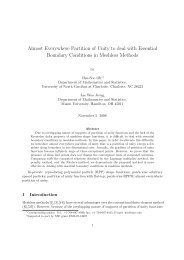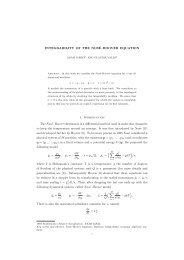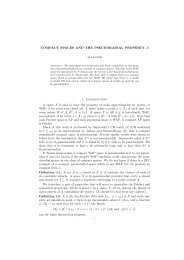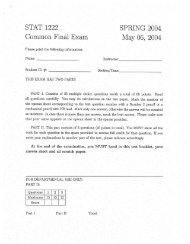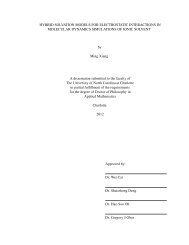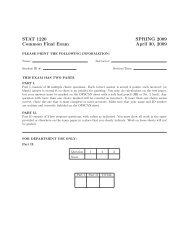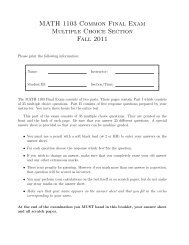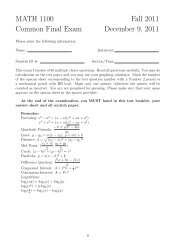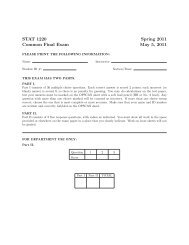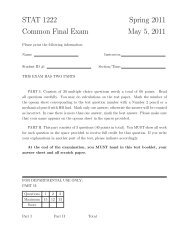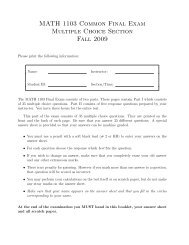STAT 1222 FALL 2011 Common Final Exam December 09, 2011
STAT 1222 FALL 2011 Common Final Exam December 09, 2011
STAT 1222 FALL 2011 Common Final Exam December 09, 2011
You also want an ePaper? Increase the reach of your titles
YUMPU automatically turns print PDFs into web optimized ePapers that Google loves.
<strong>STAT</strong> <strong>1222</strong> <strong>FALL</strong> <strong>2011</strong><br />
<strong>Common</strong> <strong>Final</strong> <strong>Exam</strong> <strong>December</strong> <strong>09</strong>, <strong>2011</strong><br />
Please print the following information:<br />
Name: Instructor:<br />
Student ID #: Section/Time:<br />
THIS EXAM HAS TWO PARTS<br />
PART I. Consists of 30 multiple choice questions worth a total of 60 points. Read<br />
all questions carefully. You may do calculations on the test paper. Mark the number of<br />
the opscan sheet corresponding to the test question number with a Number 2 pencil or a<br />
mechanical pencil with HB lead. Mark only one answer; otherwise the answer will be counted<br />
as incorrect. In case there is more than one answer, mark the best answer. Please make sure<br />
that your name appears on the opscan sheet in the spaces provided.<br />
PART II. This part consists of 3 questions (40 points in total). You MUST show all the<br />
work for each question in the space provided to receive full credit for that question. If you<br />
write your explanations in another part of the test, please indicate accordingly.<br />
At the end of the examination, you MUST hand in this test booklet, your answer<br />
sheet and all scratch paper.<br />
FOR DEPARTMENTAL USE ONLY:<br />
PART II:<br />
Questions 1 2 3<br />
Maximum 15 10 15<br />
Score<br />
Part I Part II Total
<strong>STAT</strong> <strong>1222</strong> <strong>Final</strong> <strong>Exam</strong> Dec <strong>09</strong>, <strong>2011</strong><br />
Use the following sample data to answer questions 1, 2, 3 and 4.<br />
1. Find the mean of the data.<br />
(a) 2.4<br />
(b) 2<br />
(c) 4.8<br />
(d) 3<br />
(e) 0<br />
5 2 0 1 − 2 6<br />
2. The sample standard deviation of the data set is closest to<br />
(a) -1<br />
(b) 4<br />
(c) 1.852<br />
(d) 2.170<br />
(e) 3.033<br />
3. Find the median of the data.<br />
(a) 1<br />
(b) 1.5<br />
(c) 2<br />
(d) 2.5<br />
(e) 6<br />
4. Find the first quartile of the data.<br />
(a) 6<br />
(b) 5<br />
(c) 2<br />
(d) 1<br />
(e) 0
<strong>STAT</strong> <strong>1222</strong> page 2 of 11 Dec <strong>09</strong>, <strong>2011</strong><br />
Use the following information to answer questions 5, 6 and 7<br />
The table below shows the results of a study on 102 women in which researchers examined<br />
the association between the occurrence of a mutation of the BRCA gene and breast cancer.<br />
Mutated Gene present Mutated Gene absent Total<br />
Has cancer 33 19 52<br />
Does not have cancer 39 11 50<br />
Total 72 30 102<br />
5. The probability that a randomly selected woman does not have cancer is closest to<br />
(a) .49<br />
(b) .71<br />
(c) .29<br />
(d) .34<br />
(e) .67<br />
6. The probability that a randomly selected woman has cancer and the mutated gene is<br />
present is closest to<br />
(a) .49<br />
(b) .71<br />
(c) .27<br />
(d) .32<br />
(e) .46<br />
7. The probability that a randomly selected woman has cancer or has the mutated gene, is<br />
closest to<br />
(a) 1.216<br />
(b) .892<br />
(c) .36<br />
(d) .27<br />
(e) .75
<strong>STAT</strong> <strong>1222</strong> page 3 of 11 Dec <strong>09</strong>, <strong>2011</strong><br />
The weights of bags of chips produced by Great Home Snacks company has a bell-shaped<br />
distribution with a mean of 20 ounces and a standard deviation of .07 ounces. Use this<br />
information to answer questions 8, 9 and 10.<br />
8. Approximately 68% of chips bags weigh between<br />
(a) 15 ounces and 25 ounces.<br />
(b) 19.79 ounces and 20.21 ounces.<br />
(c) 18.15 ounces and 22.5 ounces.<br />
(d) 19.86 ounces and 20.14 ounces.<br />
(e) 19.93 ounces and 20.07 ounces.<br />
9. Approximately what percentage of chips bags weigh between 19.86 and 20.07 ounces.<br />
(a) 95% (b) 81.5% (c) 99.7% (d) 67.2% (e) 90.5%<br />
10. If 200 chips bags are selected at random, about how many do you expect to weigh more<br />
than 20.14 ounces.<br />
(a) 95 (b) 10 (c) 32 (d) 25 (e) 5<br />
The probability distribution of the number of pets x per household in a certain locality is<br />
given in the following table. Use this information to answer questions 11 and 12.<br />
x 0 1 2 3 4<br />
P (x) ? .28 .40 .10 .07<br />
11. What is the probability that a randomly chosen household in this locality has no pets.<br />
(a) .5 (b) .25 (c) .15 (d) .95 (e) .35<br />
12. Find the expected number of pets in this locality.<br />
(a) 0 (b) 0.74 (c) 1.25 (d) 1.66 (e) 2.27.
<strong>STAT</strong> <strong>1222</strong> page 4 of 11 Dec <strong>09</strong>, <strong>2011</strong><br />
Use the following information to answer questions 13, 14, 15 and 16.<br />
The weights of adult Fox Terriers in US (a dog breed) are normally distributed, with a mean<br />
of 15 pounds and a standard deviation of 3 pounds.<br />
13. The probability that a randomly chosen Fox Terrier weighs between 9 pounds and 18<br />
pounds is closest to<br />
(a) 0.7961<br />
(b) 0.2514<br />
(c) 0.8185<br />
(d) 0.0475<br />
(e) .9725<br />
14. To be in the top 13% of the weights, a Fox Terrier should weigh at least<br />
(a) 18.39 pounds.<br />
(b) 25.27 pounds.<br />
(c) 17.52 pounds.<br />
(d) 20.64 pounds.<br />
(e) 15 pounds.<br />
15. A random sample of 100 Fox Terriers is drawn from this population. Identify the mean<br />
µ¯x, and standard error σ¯x, of the sample mean weight ¯x.<br />
(a) µ¯x = 15, σ¯x = .3<br />
(b) µ¯x = 1.5, σ¯x = 3<br />
(c) µ¯x = 15, σ¯x = 3<br />
(d) µ¯x = 15, σ¯x = 30<br />
(e) µ¯x = 1.5, σ¯x = .3<br />
16. Find the probability that the sample mean weight ¯x exceeds 16 pounds.<br />
(a) .9996<br />
(b) .5000<br />
(c) .6293<br />
(d) .3707<br />
(e) .0004
<strong>STAT</strong> <strong>1222</strong> page 5 of 11 Dec <strong>09</strong>, <strong>2011</strong><br />
Use the following information to answer questions 17 and 18.<br />
A car dealer wants to get information about the number of years car owners keep their cars.<br />
A random sample of 25 car owners resulted in ¯x = 7.01 years, and s = 3.74 years. Assume<br />
that the sample is drawn from a normally distributed population.<br />
17. Construct a 95% confidence interval for the mean number of years of car ownership.<br />
(a) (5.25, 8.19)<br />
(b) (5.55, 8.46)<br />
(c) (5.41, 8.29)<br />
(d) (5.47, 8.55)<br />
(e) (5, 8)<br />
18. All other information remaining unchanged, which of the following would produce a<br />
wider interval than the 95% confidence interval constructed?<br />
(a) The sample size is 29 instead of 25.<br />
(b) The sample size is 10 instead of 25.<br />
(c) Compute a 80% confidence interval rather than a 95% confidence interval.<br />
(d) Compute a 90% confidence interval rather than a 95% confidence interval.<br />
(e) The sample standard deviation is computed to be 1.52 instead of 3.74.<br />
19. An economist wants to estimate the mean income during the first year of employment<br />
for a college graduate who has had a statistics course. Find the minimum sample size<br />
needed to estimate the mean µ with 88% confidence. The estimate must be accurate<br />
to within $500 of µ. Assume σ = $6250.<br />
(a) n = 375<br />
(b) n = 257<br />
(c) n = 601<br />
(d) n = 378<br />
(e) n = 1037.<br />
20. In a survey of 2563 adults from France, 1666 said that they believed that the activities<br />
of humans are contributing to an increase in global temperatures. A 95% confidence<br />
interval for the proportion p of adults in France, who think humans are contributing<br />
to an increase in global temperatures, is closest to<br />
(a) (.3815, .4227) (b) (.5315, .7935) (c) (.6315, .6685) (d) (.1727, .7819)<br />
(e) (.2500, .7500)
<strong>STAT</strong> <strong>1222</strong> page 6 of 11 Dec <strong>09</strong>, <strong>2011</strong><br />
Use the following for questions 21, 22 and 23.<br />
A Western blot assay is a blood test for the presence of HIV. It has been found that this test<br />
some times gives false positive results for HIV. A medical researcher claims that the rate of<br />
false positives is less than 2%. A recent study of 300 randomly selected US blood donors<br />
who do not have HIV found that 3 received false positive test result.<br />
21. Set up the null and alternate hypothesis to test the researcher’s claim.<br />
(a) H0 : p = .02 vs Ha : p = .02.<br />
(b) H0 : p < .02 vs Ha : p ≥ .02.<br />
(c) H0 : p ≥ .02 vs Ha : p < .02.<br />
(d) H0 : p ≤ .02 vs Ha : p > .02.<br />
(e) H0 : p = .02 vs Ha : p = .02.<br />
22. The value of the standardized test statistic is closest to<br />
(a) 2.21<br />
(b) −2.21<br />
(c) 1.055<br />
(d) −1.24<br />
(e) 1.24<br />
23. Find the rejection region and state your decision at α = .05.<br />
(a) Rejection Region: z > 1.645; Decision: Reject H0.<br />
(b) Rejection Region: z < −1.645; Decision: Fail to reject H0.<br />
(c) Rejection Region: z < −1.96 or z > 1.96; Decision: Reject H0.<br />
(d) Rejection Region: z < 1.555; Decision: Reject H0.<br />
(e) Rejection Region: z > −1.555; Decision: Fail to reject H0.
<strong>STAT</strong> <strong>1222</strong> page 7 of 11 Dec <strong>09</strong>, <strong>2011</strong><br />
Use the following for questions 24, 25 and 26.<br />
A nutritionist in the FDA wants to compare the caloric content of medium french fries sold<br />
by Wendonald (Population 1) and McKing (Population 2) fast-food chains, to see if there<br />
is any difference between them. To test this, random samples from each chain is taken and<br />
the caloric contents of french fries are measured. Their finding is summarized in the table<br />
below.<br />
Wendonald McKing<br />
n1 = 40 n2 = 50<br />
¯x1 = 380 calories ¯x2 = 360 calories<br />
s1 = 30 calories s2 = 38 calories<br />
24. Set up the null and alternative hypotheses to test whether there is any difference<br />
between the caloric content of french fries sold by the two chains.<br />
(a) H0 : µ1 ≥ µ2 versus Ha : µ1 < µ2<br />
(b) H0 : µ1 < µ2 versus Ha : µ1 ≥ µ2<br />
(c) H0 : µ1 = µ2 versus Ha : µ1 = µ2<br />
(d) H0 : µ1 ≤ µ2 versus Ha : µ1 > µ2<br />
(e) H0 : µ1 = µ2 versus Ha : µ1 = µ2<br />
25. Find the value of the standardized test statistic.<br />
(a) −1.848 (b) 1.848 (c) −2.79 (d) 2.79 (e) −1.23<br />
26. Find the P-value for the above test and state your decision at 1% significance level.<br />
(a) P=.0052; Decision: Reject H0.<br />
(b) P=.0026; Decision: Reject H0.<br />
(c) P=.0052; Decision: Do not reject H0.<br />
(d) P=.5000; Decision: Reject H0.<br />
(e) P=.0322; Decision: Do not reject H0.
<strong>STAT</strong> <strong>1222</strong> page 8 of 11 Dec <strong>09</strong>, <strong>2011</strong><br />
Use the following information to answer questions 27–30.<br />
The data below are the number of absences and the final grades of 9 randomly chosen<br />
students from a statistics class.<br />
Number of absences, x 0 3 6 4 9 2 15 8 5<br />
<strong>Final</strong> grade, y 98 86 80 82 71 92 55 76 82<br />
<br />
x = 52, <br />
y = 722, <br />
x 2 = 460, <br />
y 2 = 59154, <br />
xy = 3732.<br />
27. Find the sample correlation coefficient r.<br />
(a) .5000 (b) −.6255 (c) .6255 (d) .9908 (e) −.9908<br />
28. We would like to test whether there is significant linear relationship between number of<br />
absences and <strong>Final</strong> Grade, i.e., H0 : ρ = 0 versus Ha : ρ = 0. The value of the test<br />
statistic for this test is closest to<br />
(a) −19.37 (b) 19.37 (c) −.9908 (d) 2.5719 (e) 0<br />
29. Find the rejection region at α = .02 significance level and state your conclusion.<br />
(a) Rejection region: t < −2.998 or t > 2.998; Decision: Reject H0.<br />
(b) Rejection region: t < −2.998; Decision: Do not reject H0.<br />
(c) Rejection region: t < −3.499 or t > 3.499; Decision: Reject H0.<br />
(d) Rejection region: t < −3.499 or t > 2.998; Decision: Do not reject H0.<br />
(e) Rejection region: t < −2.998 or t > 2.998; Decision: Do not reject H0.<br />
30. The equation of the best fit line relating x, the number of absences, to y, the <strong>Final</strong><br />
grade is ˆy = −2.755x + 96.139. Student A missed 7 classes while student B missed 25<br />
classes. The predicted <strong>Final</strong> Grades for these students are as follows:<br />
(a) student A: 76.854; student B: 27.264.<br />
(b) student A: 89.33; student B: 50.235<br />
(c) student A: 76.854; student B: predicting using the regression line is not meaningful.<br />
(d) student A: predicting using the regression line is not meaningful; student B: pre-<br />
dicting using the regression line is not meaningful.<br />
(e) student A: predicting using the regression line is not meaningful; student B: 27.264.<br />
End of Multiple Choice Section
<strong>STAT</strong> <strong>1222</strong> Part II Dec <strong>09</strong>, <strong>2011</strong><br />
1. Consider the following table that lists SAT scores before and after a sample of five students<br />
took a preparatory course.<br />
Student 1 2 3 4 5<br />
SAT score before course 700 840 830 860 690<br />
SAT score after course 720 840 820 900 700<br />
(a) (2 pts.) State the correct hypotheses to test the effectiveness of the course in<br />
improving the SAT scores.<br />
H0 : Ha :<br />
(b) (2 pts.) In the context of the problem, explain Type I error and Type II error.<br />
Type I Error:<br />
Type II Error:<br />
(c) (5 pts.) Find the value of the standardized test statistic.<br />
(d) (3 pts.) Find the rejection region at α = .05
<strong>STAT</strong> <strong>1222</strong> page 10 of 11 Dec <strong>09</strong>, <strong>2011</strong><br />
(e) (3 pts.) State your conclusion in the context of the problem.<br />
2. The data below are the ages (in years) of 10 men and their systolic blood pressures.<br />
Age, x 16 25 39 45 49 64 70 29 57 22<br />
Systolic blood pressure, y 1<strong>09</strong> 122 143 132 199 185 199 130 175 118<br />
x = 416, y = 1512, x 2 = 20398, y 2 = 239514, xy = 68173.<br />
(a) (7 pts.) Find the equation of the regression line.<br />
Regression line: ˆy = mx + b where m= b =<br />
(b) (3 pts) Find the coefficient of determination. Explain what it represents?
<strong>STAT</strong> <strong>1222</strong> page 11 of 11 Dec <strong>09</strong>, <strong>2011</strong><br />
3. It is believed that mean bumper repair costs for low speed crashes is less for small cars<br />
than it is for midsize cars. In order to test this claim, the following data was collected<br />
on a sample of small cars and a sample of midsize cars.<br />
Small Car Midsize Car<br />
n1 = 12 n2 = 16<br />
¯x1 = $473 ¯x2 = $741<br />
s1 = $190 s2 = $205<br />
Assume that the repair costs are normally distributed with equal population vari-<br />
ances.<br />
(a) (2 points) Set up the null and alternative hypotheses to test the claim.<br />
H0 : Ha :<br />
(b) (5 points) Find the value of the appropriate standardized test statistic and say<br />
whether it is a t or z.<br />
(c) (5 points) Find the rejection region at 1% significance level.<br />
(d) (3 points) State your conclusion in the context of the problem.



